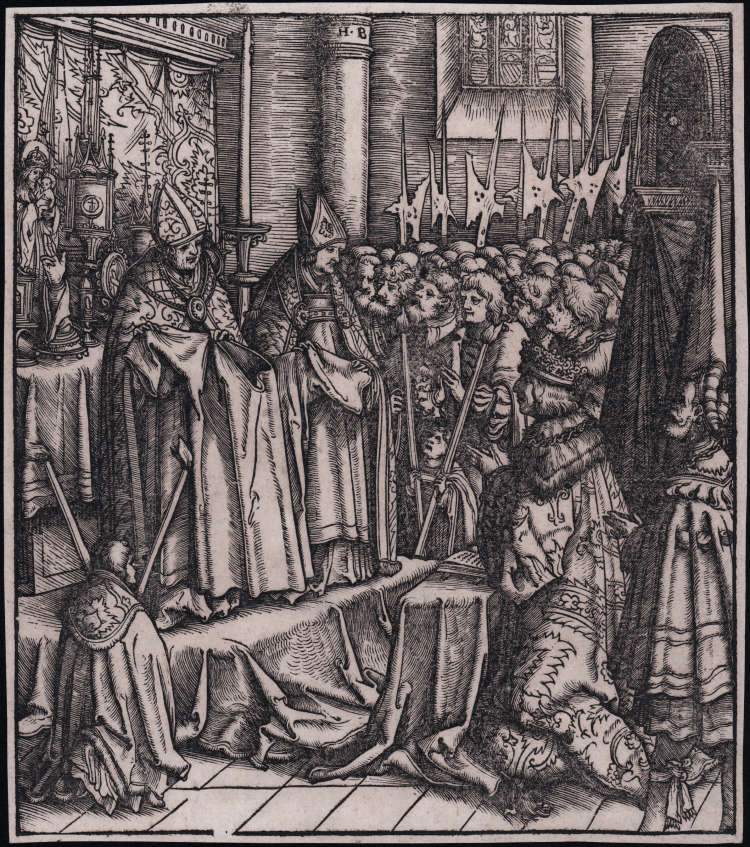



| Reference: | S41942 |
| Author | Hans BURGKMAIR "Il Vecchio" |
| Year: | 1514 ca. |
| Measures: | 195 x 220 mm |


| Reference: | S41942 |
| Author | Hans BURGKMAIR "Il Vecchio" |
| Year: | 1514 ca. |
| Measures: | 195 x 220 mm |
Woodcut, 1514-1516 circa, signed with monogram H B on the upper column,
From the series Der Weisskunig (the White King); It is an idealised biography of Maximilian, with two early sections on the life of his parents, and his birth and education, which were compiled by Maximilian's secretary, Marx Treitzsaurwein, and a longer third section dealing with the political history of Maximilian's reign, for which the Emperor himself was primarily responsible. All the characters are given pseudonyms, many of which are derived from their heraldic arms; thus for example, Maximilian is the Young White King, Frederick III the Old White King, and the King of France is the Blue King. The text was dictated by Maximilian to Treitzsaurwein and has survived in various manuscripts in the Österreichische National-bibliothek in Vienna (see 'Maximilian I, 1459-1519', exh. cat., Vienna, 1959, pp.26f, with literature). Its confused state is reflected in the woodcut illustrations which were carried out at Augsburg under Peutinger's supervision. Some subjects were cut twice, others were omitted, and some represent subjects not in the text, as far as it was completed. Out of 236 illustrations, of which 223 of the blocks have survived (Vienna, Albertina), Burgkmair was responsible, according to Dodgson, for the design of 121. The other main designer was Leonhard Beck; Hans Springinklee and Hans Schäufelein contributed a few designs each to the project (see 1837,0616.308). The blocks were cut between 1514 and 1516 by a group of cutters supervised by Jost de Negker, and a few contemporary sets of proofs have survived, the most important of which are in Vienna, Stuttgart and formerly in the Liechtenstein collection, now in Boston (see Musper, pp. 102ff). In 1526 Maximilian's grandson, the Archduke Ferdinand, commissioned Treitzsaurwein to complete and publish 'Der Weisskunig', but this plan was frustrated by Treitzsaurwein's death in 1527. It was not until 1775, after the blocks had been found at Graz, that it was published in book form by Hoffstätter in Vienna.
There are ninety proof impressions of the series in the British Museum which would have been taken while work on the blocks was in progress during the life of Maximilian.
Good example, printed on contemporary laid paper, very good condition.
When Emperor Maximilian I came to Treves for the Imperial Diet in 1512, he asked to see Holy Coat which was kept in the Cathedral. Archbishop Richard von Greiffenklau arranged the opening of the altar that had enshrined the tunic since the building of the Dome and exhibited it. The people of Treves heard about that and demanded to see the Holy Coat.
|
Hollstein V.117.448; Bartsch VII.224.80-35; Dodgson II.93.58.
|
Hans BURGKMAIR "Il Vecchio" (Ausburg 1473 circa - 1531)
|
Hans Burgkmair, a German painter, woodcut designer, and draughtsman, was born in Augsburg in 1473 and died in the same city in 1531. He studied painting with Martin Schongauer from 1488-1489 but, shortly after that, he began making designs for woodcuts for the printer, Erhart Ratdolt, in Augsburg. His early works included portraits and paintings commissioned by churches. After a trip to Italy in 1507, his work showed the influence of Renaissance concepts of space and architecture and coloring. About 1509, Burgkmair began making woodcut designs for various projects commissioned by Emperor Maximilian I (1459-1519), including the Weisskunig for which he designed 118 woodcuts out of a total of 251 during the period of ca. 1514 to 1518. Then, from ca. 1516 to 1518, he also designed about half of the woodcuts for Maximilian's Triumphal Procession. It is for these series of woodcuts for Maximilian that Burgkmair is most well-known. After Maximilian's death in 1519, Burgkmair returned to painting and drawing. In his last years, Burgkmair designed some woodcuts to illustrate Luther's translation of the New Testament which was published in Augsburg in 1523. He also produced some history paintings for William IV, Duke of Bavaria. Along with Dürer, Lucas Cranach, Altdorfer, and Grünewald, Burgkmair was one of the most important 16th-century artists.
|
|
Hollstein V.117.448; Bartsch VII.224.80-35; Dodgson II.93.58.
|
Hans BURGKMAIR "Il Vecchio" (Ausburg 1473 circa - 1531)
|
Hans Burgkmair, a German painter, woodcut designer, and draughtsman, was born in Augsburg in 1473 and died in the same city in 1531. He studied painting with Martin Schongauer from 1488-1489 but, shortly after that, he began making designs for woodcuts for the printer, Erhart Ratdolt, in Augsburg. His early works included portraits and paintings commissioned by churches. After a trip to Italy in 1507, his work showed the influence of Renaissance concepts of space and architecture and coloring. About 1509, Burgkmair began making woodcut designs for various projects commissioned by Emperor Maximilian I (1459-1519), including the Weisskunig for which he designed 118 woodcuts out of a total of 251 during the period of ca. 1514 to 1518. Then, from ca. 1516 to 1518, he also designed about half of the woodcuts for Maximilian's Triumphal Procession. It is for these series of woodcuts for Maximilian that Burgkmair is most well-known. After Maximilian's death in 1519, Burgkmair returned to painting and drawing. In his last years, Burgkmair designed some woodcuts to illustrate Luther's translation of the New Testament which was published in Augsburg in 1523. He also produced some history paintings for William IV, Duke of Bavaria. Along with Dürer, Lucas Cranach, Altdorfer, and Grünewald, Burgkmair was one of the most important 16th-century artists.
|